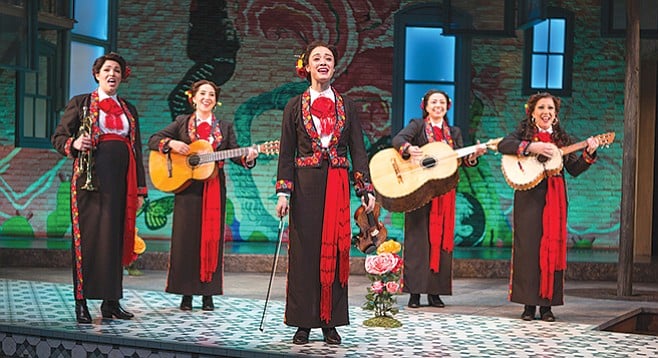 Facebook
Facebook
 X
X
 Instagram
Instagram
 TikTok
TikTok
 Youtube
Youtube

Occasionally, an experience forces me to reflect on just how much American culture has twisted around what we pay attention to in music. And I don’t know whether to be proud or disturbed.
Manufactured pop has been the dominant art form for decades, often accompanied by elaborate stage spectacles characterized by troupes of lip-syncing dancers. If it’s catchy and fresh, and you can shake your booty. It sells.
Meanwhile, our most accomplished musicians don’t show up in mainstream culture. They’re more likely to be playing background music. Like the soundtrack in an office building lobby, or the hold music while you’re waiting for customer service. Think chamber music, think jazz.
Think mariachi. American Mariachi, playing at the Old Globe through April 29, gets it out of the way early, with a winking joke to the audience: Americans associate mariachi with the bands stalking your table at Mexican restaurants. And we don’t always like it.
But learning even a very little bit about something can inspire a greater appreciation. If more of us had a better understanding of the mastery mariachi musicians bring to provide restaurant “atmosphere ,” we would all be in a rush to tip them better.
Mariachi musicians appear throughout the play, performing traditional tunes plus a couple of new pieces. At one point, we’re quickly taught a few of the different rhythms employed by the three different sizes of mariachi stringed instrument: the guitar; the large, bassy guitarrón; and the small, ukelele-like vihuela.
There are no drums in a mariachi, so strumming techniques set the time and feel. Simpler ranchera forms draw from European time signatures such as the waltzy 3/4. Lusty boleros are played in slow 4/4 to rouse a romantic feeling. The musician strums up, strums down, quickly mutes the strings with a quick slap of the palm, or drags a strum for a pronounced arpeggio. All four techniques may show up in a single bar, happening almost too fast be understood on a casual listen. The really challenging stuff shows up in a huapango, which makes a subtle shift each bar between 3/4 and 6/8; a concept almost impossible to reconcile with modern pop. Factor in harmonizing voices, flourishes, and embellishments, and mariachi music proves impressively difficult to master.
American Mariachi tackles a conceit of Mexican-American culture in the 1970s: the idea that females couldn’t handle such intricacies, despite the fact that it had been roundly debunked by a slew of successful all-women mariachi groups that arose in Mexico in the 1950s.
Are the challenges of culture, gender, and ethnicity in America more difficult to surmount than refined musical compositions? If you turn on the radio, it doesn’t always sound like we’re doing well in either regard. But it’s usually the case: stop to genuinely listen, and anything becomes easier to appreciate.


Occasionally, an experience forces me to reflect on just how much American culture has twisted around what we pay attention to in music. And I don’t know whether to be proud or disturbed.
Manufactured pop has been the dominant art form for decades, often accompanied by elaborate stage spectacles characterized by troupes of lip-syncing dancers. If it’s catchy and fresh, and you can shake your booty. It sells.
Meanwhile, our most accomplished musicians don’t show up in mainstream culture. They’re more likely to be playing background music. Like the soundtrack in an office building lobby, or the hold music while you’re waiting for customer service. Think chamber music, think jazz.
Think mariachi. American Mariachi, playing at the Old Globe through April 29, gets it out of the way early, with a winking joke to the audience: Americans associate mariachi with the bands stalking your table at Mexican restaurants. And we don’t always like it.
But learning even a very little bit about something can inspire a greater appreciation. If more of us had a better understanding of the mastery mariachi musicians bring to provide restaurant “atmosphere ,” we would all be in a rush to tip them better.
Mariachi musicians appear throughout the play, performing traditional tunes plus a couple of new pieces. At one point, we’re quickly taught a few of the different rhythms employed by the three different sizes of mariachi stringed instrument: the guitar; the large, bassy guitarrón; and the small, ukelele-like vihuela.
There are no drums in a mariachi, so strumming techniques set the time and feel. Simpler ranchera forms draw from European time signatures such as the waltzy 3/4. Lusty boleros are played in slow 4/4 to rouse a romantic feeling. The musician strums up, strums down, quickly mutes the strings with a quick slap of the palm, or drags a strum for a pronounced arpeggio. All four techniques may show up in a single bar, happening almost too fast be understood on a casual listen. The really challenging stuff shows up in a huapango, which makes a subtle shift each bar between 3/4 and 6/8; a concept almost impossible to reconcile with modern pop. Factor in harmonizing voices, flourishes, and embellishments, and mariachi music proves impressively difficult to master.
American Mariachi tackles a conceit of Mexican-American culture in the 1970s: the idea that females couldn’t handle such intricacies, despite the fact that it had been roundly debunked by a slew of successful all-women mariachi groups that arose in Mexico in the 1950s.
Are the challenges of culture, gender, and ethnicity in America more difficult to surmount than refined musical compositions? If you turn on the radio, it doesn’t always sound like we’re doing well in either regard. But it’s usually the case: stop to genuinely listen, and anything becomes easier to appreciate.
Comments